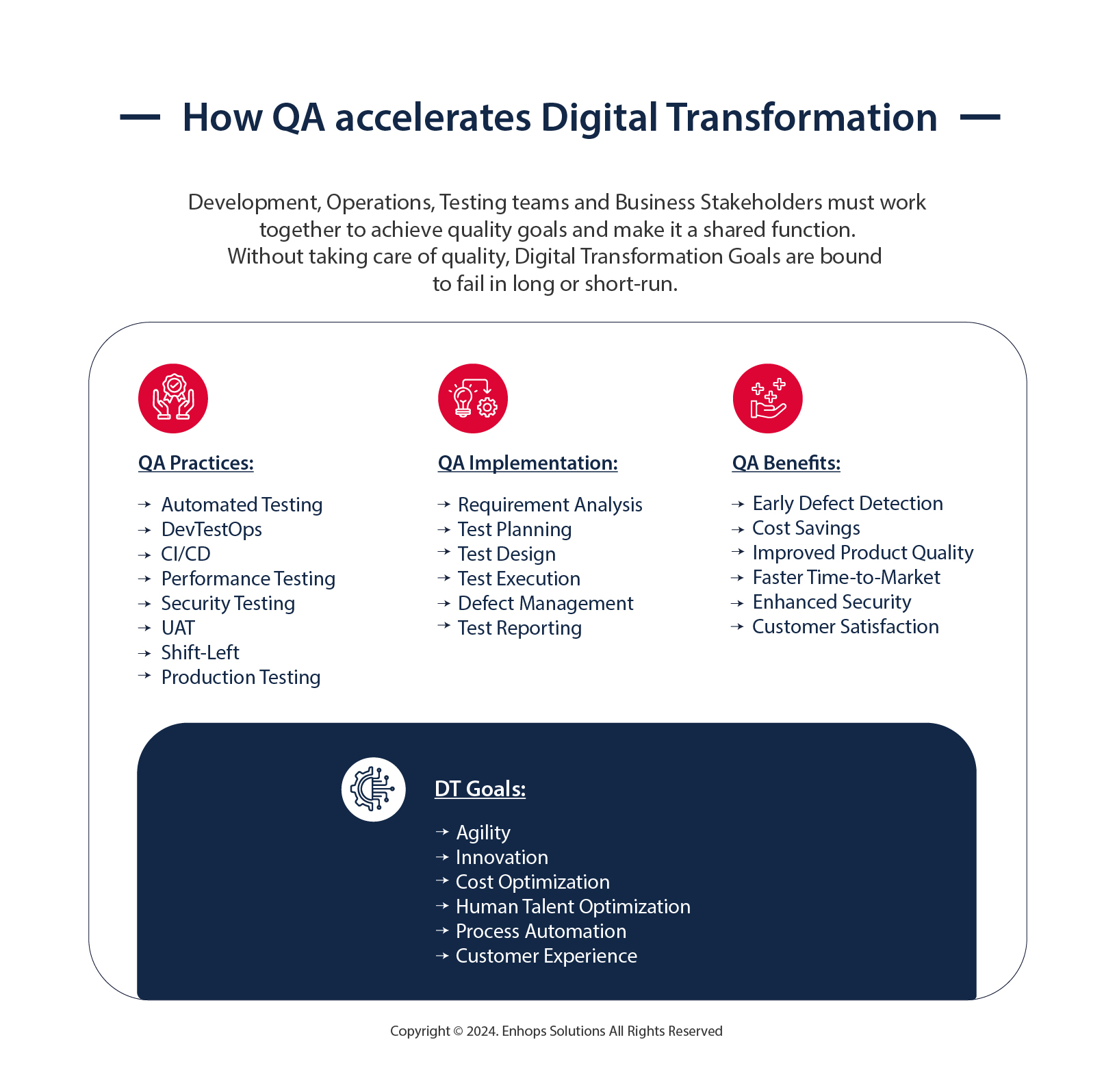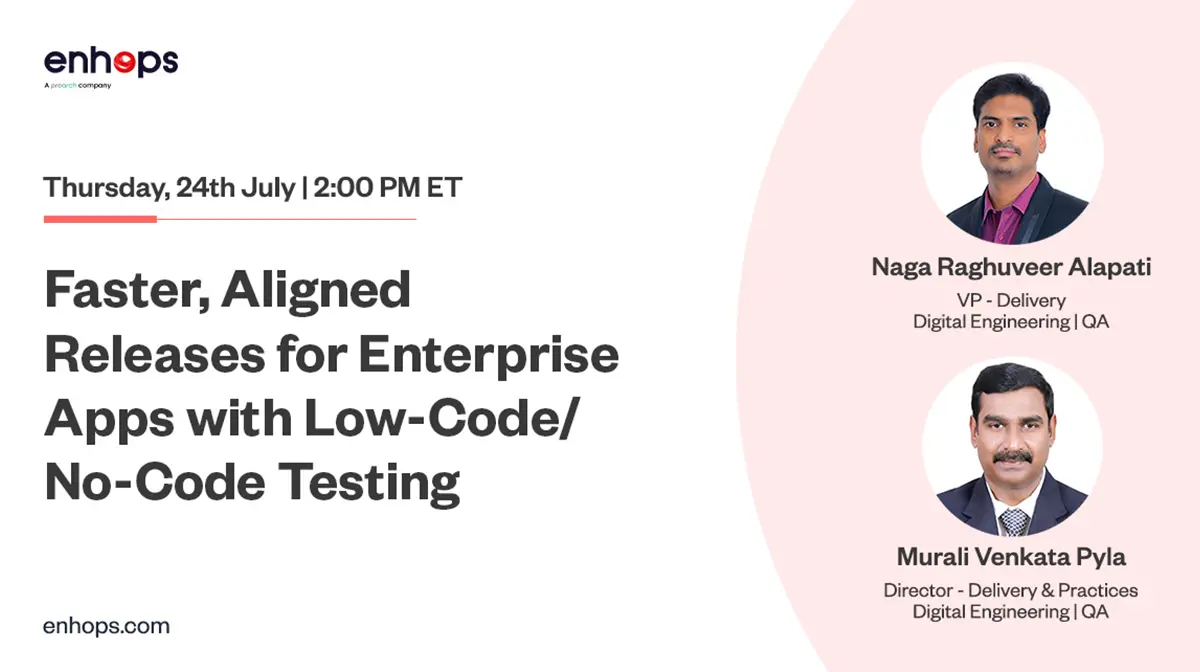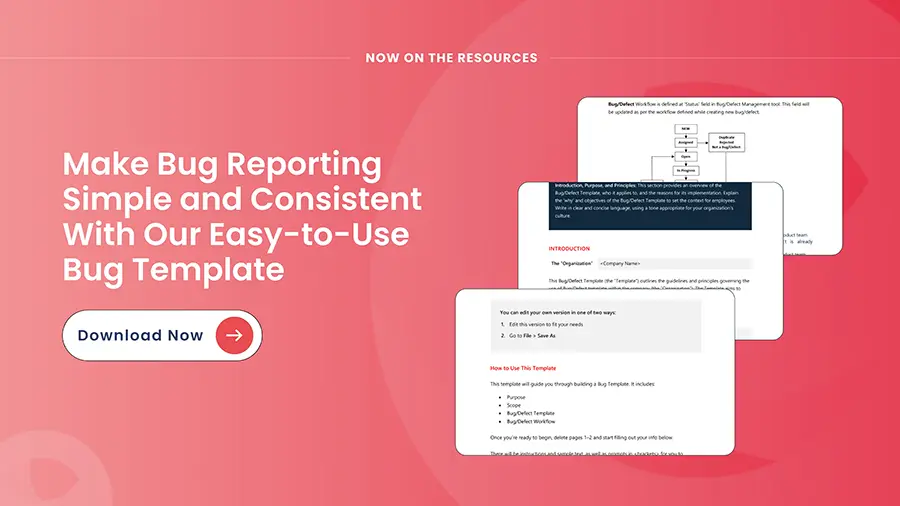In digital age, organizations are expected to provide a seamless user experience across every channel and device. Without taking quality in consideration from day one, it is impossible for organizations to deliver this experience. Hence, there’s a need to understand how software engineering teams can transform their quality assurance practices to deliver seamless experience.
This article explains how to transform the Quality Assurance function within your organization and how Enhops can help.
What is Quality Assurance Transformation
A quality transformation is characterized by changing the way traditional testing works. It involves automating test processes, shifting testing practices to the left, tracking right metrics, and improving collaboration between development, operations, and testing teams to deliver high-quality applications.
Quality Assurance transformation emphasizes people, processes, and technology. A successful QA transformation brings agility with simple and automated processes, technology enabling faster SDLC, and an empowered workforce with a free flow of knowledge.
Why Quality Assurance Transformation is essential
With quality goals in place, digital transformation or AI efforts will succeed in the long and the short run. Why? Customers want seamless user experience. Let’s take a closer look at why QA transformation is vital.
1. Enhance application/product quality
Quality Assurance transformation helps elevate testing maturity levels and improve testing practices. QA transformation brings in the required balance of manual and automated testing, enabling teams to ensure maximum test coverage for releasing high-quality products.
2. Optimize technical debt
Quality Assurance (QA) transformation helps to optimize technical debt by leveraging QA automation. For existing applications, this means automating test processes and identifying poorly written codes in applications and fixing them using automated processes. For new applications, the QA process can be tightly integrated with the development, leading to faster feedback loops and early identification of bugs.
3. Reduce time to market
With automation in place, QA processes can move from manual to automated testing in each phase. This ensures testers can take up more work and tests products faster.
4. Maximize ROI
QA transformation maximizes ROI by minimizing the need for code checking and development before release. When testing is integrated and occurs alongside development and operations in a unified manner, all processes move faster and more efficiently.
5. Enhance Risk Management
QA transformation enhances risk management so risky codes or errors don’t move downstream, harming end-users or causing revenue losses. It helps in identifying risks early in the development lifecycle.
How QA can accelerate Digital Transformation
The core focus areas of any digital transformation initiative include increasing agility, fostering innovation and new product development, enhancing customer experience, adopting a data-driven culture, and unlocking new levels of human efficiency. Software development and testing play a crucial role in all these areas. Therefore, prioritizing quality is essential in all digital transformation efforts.
QA Transformation practices, such as Test Automation, DevTestOps, Shift-Left Testing, Pair Programming, Chaos Engineering, and Continuous Testing, are critical in supporting the direct goals of digital transformation.

Quality Assurance Transformation Elements
Broadly, there are three aspects of quality assurance transformation: People, Processes, and Technology. People include automation and manual engineers, processes include moving away from traditional QA practices to Quality Engineering, and technology involves bringing in automation, shift-left, and defect prevention technologies to revamp quality.
People: For any organization to achieve QA transformation, it is important to avoid testers being the last to review code and highlight issues. Successful software teams and organizations now work with software developers in testing (SDETs). SDETs work closely with development teams and understand application architecture, develop test automation suites, and maintain and run them. While a few years ago, testing was all about recording and playing back each and every application functionality, successful teams are now using strategies like Test-Driven Development, Keyword-Driven Development, and Behavior Development to keep up with the development speed.
Processes: With the advent of DevOps and Agile, there’s manual testing cannot keep up with them. Organizations need to transform their critical manual QA processes into automated processes. This requires standardized use of methods, tools, and best practices among various teams in the organization. Additionally, there’s a need to identify proper knowledge-sharing and management ways to align everyone per the quality goals. TCoE services help standardize these processes and enable knowledge sharing across organizations.
Technology: Technology transformation involves using advanced practices like no-code and low-code test automation tools with intelligent automation capabilities. Multiple tools and platforms are available in the market to support automated and faster test cycles, including intelligent test data management, test case maintenance, chaos engineering, and more. Work alongside a specialized partner to understand what will work best for you and your teams.
It is essential to automate both functional and non-functional aspects of testing, including performance and security testing. As AI and ML technologies become mainstream, testing teams can leverage them to enhance their testing practices. AI and ML can help identify patterns, predict potential issues, and optimize testing processes. Continuous load testing, for instance, ensures that an application can handle expected user loads and helps identify performance bottlenecks.
Quality Assurance Transformation Practices
• Quality Mindset: It is important for everyone in the organization to believe and understand quality-mindset. A quality-first mindset changes how an organization thinks, creates, and delivers products. Everyone must be on board with the change from the CEO to the software developer. This helps create a shared understanding of new processes, technologies, and best practices aligned with overall business goals. The fundamental principle here is to emphasize the importance of quality for the organization and how every role contributes to it. Practical activities such as lunch-and-learn sessions, workshops, successful proof of concepts, and upskilling can help employees adopt a quality-first mindset.
• Continuous Testing: Continuous testing helps teams test codes without any manual interference. As soon as codes are checked in environments, test suites are automatically run to ensure they are running as expected. Baking CI-CD pipelines with a test automation suite can be tricky. It is advised to work with experts to ensure that your current processes run as usual and can be topped with continuous testing.
• AI-Powered QA Transformation: AI and ML technologies can significantly enhance testers’ efficiency by accelerating the creation of test cases and uncovering a broader range of scenarios more quickly. These tools aid in faster debugging, pattern recognition, and understanding test outcomes. Additionally, AI can expedite the generation of test data and streamline regression testing to pinpoint how changes in code impact different areas of an application.
AI systems can automate repetitive testing tasks with human assistance, allowing testers to focus on more complex issues. Testers can use AI-baked tools to predict future failures by analyzing historical test data, thereby improving software reliability.
• Shift-Left: In Shift-Left practices, testers are involved early in the software development lifecycle. This happens as the role of traditional testers evolved into SDETs, test strategies for applications are defined since the beginning, pair testing and pair programming are encouraged, and automation helps in executing repetitive tasks like integration testing, API testing, and non-functional testing. Testing is not an after-thought but a conscious effort towards better digital applications.
• Non-Functional Test (NFT) Automation: Non-functional application aspects are important to overall QA transformation. Hence, it is recommended to automate performance and security testing to ensure the application’s performance and scalability are not compromised. NFT automation can be baked within the test automation suite and can be part of continuous testing.
• Continuous Improvement: QA transformation ensures that the right metrics are captured from the beginning, and new processes must help improve these metrics. Metrics like average time to recover, bugs per release, average time to release, and employer productivity are kept in mind to improve the QA alignment and goals.
QA Transformation with Enhops
QA Transformation is essential to meet current expectations of faster delivery while maintaining quality. Outsourcing your QA transformation ensures you have experts to navigate the QA challenges in your software setup.
Our QA experts cater to the diverse needs of large, medium, and small enterprises, offering tailored solutions. With minimal client involvement, our zero-risk and no-commitment PoC helps clients experience the tangible benefits of QA transformation. Contact us today to get started and scale up your testing initiatives.
Reach us at Contact Us or drop your query at marketing@enhops.com




